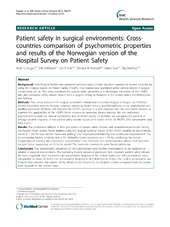| dc.contributor.author | Haugen, Arvid Steinar | en_US |
| dc.contributor.author | Søfteland, Eirik | en_US |
| dc.contributor.author | Eide, Geir Egil | en_US |
| dc.contributor.author | Nortvedt, Monica Wammen | en_US |
| dc.contributor.author | Aase, Karina | en_US |
| dc.contributor.author | Harthug, Stig | en_US |
| dc.date.accessioned | 2011-04-11T09:16:52Z | |
| dc.date.available | 2011-04-11T09:16:52Z | |
| dc.date.issued | 2010-09-22 | eng |
| dc.identifier.issn | 1472-6963 | |
| dc.identifier.uri | https://hdl.handle.net/1956/4650 | |
| dc.description.abstract | Background: How hospital health care personnel perceive safety climate has been assessed in several countries by using the Hospital Survey on Patient Safety (HSOPS). Few studies have examined safety climate factors in surgical departments per se. This study examined the psychometric properties of a Norwegian translation of the HSOPS and also compared safety climate factors from a surgical setting to hospitals in the United States, the Netherlands and Norway. Methods: This survey included 575 surgical personnel in Haukeland University Hospital in Bergen, an 1100-bed tertiary hospital in western Norway: surgeons, operating theatre nurses, anaesthesiologists, nurse anaesthetists and ancillary personnel. Of these, 358 returned the HSOPS, resulting in a 62% response rate. We used factor analysis to examine the applicability of the HSOPS factor structure in operating theatre settings. We also performed psychometric analysis for internal consistency and construct validity. In addition, we compared the percent of average positive responds of the patient safety climate factors with results of the US HSOPS 2010 comparative data base report. Results: The professions differed in their perception of patient safety climate, with anaesthesia personnel having the highest mean scores. Factor analysis using the original 12-factor model of the HSOPS resulted in low reliability scores (r = 0.6) for two factors: "adequate staffing" and "organizational learning and continuous improvement". For the remaining factors, reliability was ≥ 0.7. Reliability scores improved to r = 0.8 by combining the factors "organizational learning and continuous improvement" and "feedback and communication about error" into one six-item factor, supporting an 11-factor model. The inter-item correlations were found satisfactory. Conclusions: The psychometric properties of the questionnaire need further investigations to be regarded as reliable in surgical environments. The operating theatre personnel perceived their hospital's patient safety climate far more negatively than the health care personnel in hospitals in the United States and with perceptions more comparable to those of health care personnel in hospitals in the Netherlands. In fact, the surgical personnel in our hospital may perceive that patient safety climate is less focused in our hospital, at least compared with the results from hospitals in the United States. | en_US |
| dc.language.iso | eng | eng |
| dc.publisher | BioMed Central | eng |
| dc.relation.ispartof | <a href="http://hdl.handle.net/1956/8502" target="blank">Impact of a surgical safety checklist on safety culture, morbidity, and mortality. A stepped-wedge cluster randomised controlled trial</a> | eng |
| dc.rights | Attribution CC BY | eng |
| dc.rights.uri | http://creativecommons.org/licenses/by/2.0 | eng |
| dc.title | Patient safety in surgical environments: Cross-countries comparison of psychometric properties and results of the Norwegian version of the Hospital Survey on Patient Safety | en_US |
| dc.type | Peer reviewed | |
| dc.type | Journal article | |
| dc.description.version | publishedVersion | en_US |
| dc.rights.holder | Haugen et al. | |
| dc.rights.holder | Copyright 2010 Haugen et al; licensee BioMed Central Ltd. | |
| dc.source.articlenumber | 279 | |
| dc.identifier.doi | https://doi.org/10.1186/1472-6963-10-279 | |
| dc.identifier.cristin | 519021 | |
| dc.source.journal | BMC Health Services Research | |
| dc.source.40 | 10 | |

